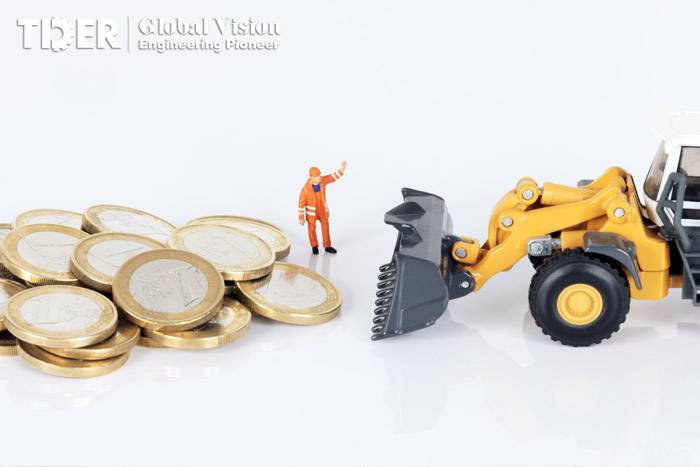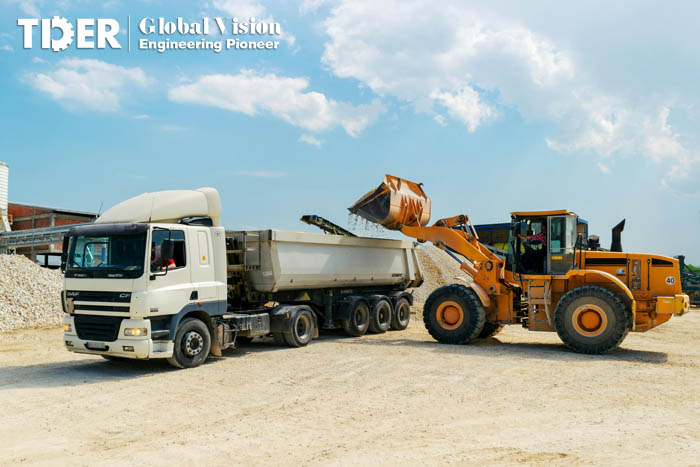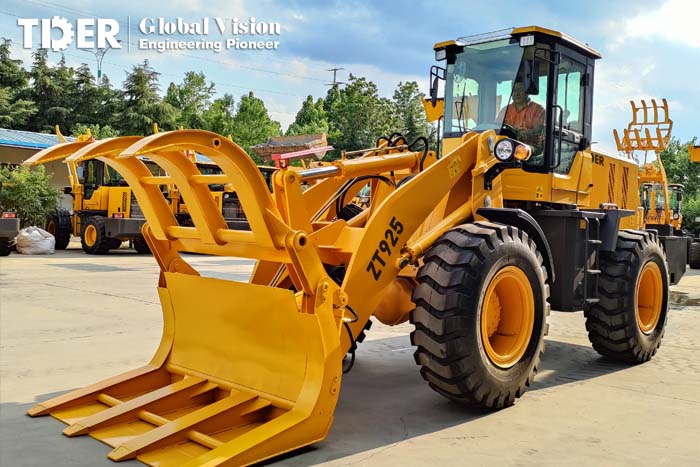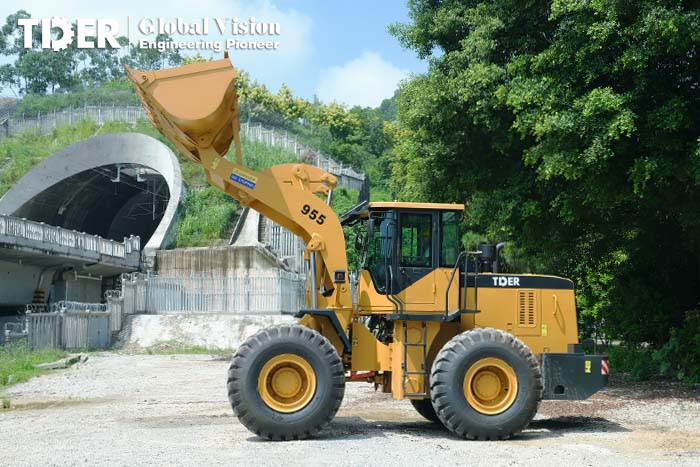Service Hotline:86-0592-5681408 / 86-17346269651
Amid the sustained growth of the global construction machinery market, wheel loaders—widely used in road, rail, construction, hydropower, ports, and mining—are evolving toward intelligent, green, and international development. Market demand is increasingly diversified. Well-known brands such as Caterpillar, TDER, Komatsu, and Liebherr have become preferred choices for global customers, thanks to their technological innovation, broad product lines, and comprehensive after-sales service.
So how can customers worldwide choose the right wheel loader in the face of so many complex options?

I. Application-Oriented Selection: Precisely Identifying Core Requirements
1. In-depth Analysis of Working Conditions:
Road & Infrastructure Construction: Focus on mobility and load capacity (10–30 tons); suitable for asphalt/aggregate handling and roadbed leveling. Four-wheel drive systems are necessary for soft surfaces.
Logistics, Warehousing & Ports: Medium tonnage (5–15 tons) with short wheelbase and articulated steering for maneuvering in tight spaces like container yards and pallet handling.
Agriculture & Light-Duty Work: Small wheel loaders (<5 tons) equipped with lightweight buckets or fork attachments; used for mixing feed or transporting fruits and vegetables; emphasizes maneuverability and fuel efficiency.
2. Adaptation to Special Environments:
Muddy / Rugged Terrain: Four-wheel drive, high ground clearance, deep-tread tires for enhanced passability.
Low Temperature / High Altitude: Engine preheaters and turbochargers to prevent power loss.
Dusty / Explosion-Proof Zones: Sealed cabins, high-efficiency air filtration, or electric / explosion-proof certified models.

II. Key Performance Parameters: Decision Matrix
In the selection process of wheel loader, the core performance parameters are the key factors to decide whether it is suitable for the operational needs, through the analysis of the load and bucket capacity, lifting height and wheelbase, operating cycle time (three and), maximum unloading height and distance, as well as the power and drive form and other key parameters, you can more scientifically select the wheel loader suitable for a particular scenario to ensure that the equipment in different working conditions can play the best performance. Ensure the best performance of the equipment under different working conditions.
Parameter | Selection Logic | Typical Application |
Load Capacity & Bucket Volume | Rated load ≥ max payload + 10–20% buffer; bucket volume matches material density & truck bed size | Mining 30 tons of ore → 40-ton loader + 6m³ rock bucket |
Lifting Height & Wheelbase | Lifting height ≥ unloading point by 1–2m; short wheelbase for narrow spaces, long rigid chassis for open areas | Warehouse aisle (3m) → 0.6 Tonne Wheel Loader with ≤2.5-meter wheelbase |
Operating Cycle Time (“3-in-1”) | Arm lift + bucket tilt + arm down time; lower total time = higher efficiency | Logistics center → Loader with ≤4s cycle time |
Max Dump Height | Height from ground to bucket tip at 45° tilt | Mining site → Dump height ≥3.5m for large trucks; Construction site → ≥2.5m |
Max Dump Distance | Distance between bucket tip and front tire at 45° | Construction → Choose ≥2m for long-distance unloading |
Powertrain & Drive Type | Diesel 4WD for heavy/outdoor work (torque reserve ≥1.5); Electric RWD for indoor/eco use (noise ≤70dB); Hydrogen fuel for high-frequency zones (3-min refill) | Food plant → Electric loader (zero emissions) |
III. Attachments & Functional Expansion Plans
The versatility of a wheel loader depends heavily on its attachment options. The chart below outlines attachment types, applicable scenarios, efficiency gains, and names. Smart attachment combinations allow one loader to handle multiple tasks, reduce redundant investment, and improve work efficiency.
Attachment Type | Application | Efficiency Value | Examples |
Fork Attachments | Replaces forklifts for pallet handling (requires fork frame) | One machine, multiple uses | Bale grab, log grab, pipe clamp, pallet fork |
Side Dump Buckets | Tunnel/narrow space unloading | 30% faster than traditional buckets | Rock bucket, coal bucket, 4-in-1/6-in-1 buckets |
Weighing System | Real-time bucket load display (±2% accuracy) | Prevents overload damage, ensures precise control | Onboard loader scale |
Sweeper Attachments | Cleans debris, replaces manual sweeping | Up to 5,000 m²/hour | Snow blade, snow sweeper, snow blower, cleaning bucket |

IV. Key Factors in Global Procurement
1. Regional Regulations and Certifications
1.1 Emission Compliance:
China: Tier 2 engines required.
EU: DPF + SCR required for diesel; CE-PED certification for electric. Euro III or V standards required for countries like Turkey.
North America: Non-road machinery must include emission control devices; electric loaders may qualify for up to 30% rebates. EPA-compliant engines required.
1.2 Safety Certifications:
OSHA (North America): Mandatory ROPS (ISO 3471) + FOPS (ISO 3449); 180° unobstructed cabin visibility.
GCC (Middle East): Engine cooling must pass local high-heat testing (≥50°C with no overheat alarm).
2. Spare Parts & Localization
Key Component Supply:
Brands with generic engines/transmissions benefit from global service networks but may face long lead times and high costs. Chinese brands like Xinchai are mature and widely preferred with fewer after-sales issues.
Spare Parts for Emerging Markets:
In regions like Africa, it's recommended to stock wear parts like tires, filters, and seals locally due to high shipping costs and long lead times.
Localized Customization:
Adaptations such as enhanced cooling grilles for Southeast Asia and dual air filters for dusty Middle Eastern conditions improve machine reliability.
3. Extreme Climate Adaptation Plans
Tropical & Rainy Regions:
Anti-corrosion chassis: Galvanized steel + triple anti-rust coating
Cooling upgrade: Larger fans + intelligent thermal control
Cold Regions (< -30°C):
Hydraulic preheating: Auto-warms to 20°C pre-start
Cabin insulation: Double-sealed glass + fuel heaters (maintains 18–22°C inside)
Desert Regions:
Dual-stage desert filtration to prevent dust ingress and prolong engine life

By focusing on essential parameters and matching the right attachments, while considering global regulatory requirements and operating environments, businesses can choose high-performance and cost-effective wheel loaders tailored for applications like road construction, logistics, and agriculture—achieving maximum operational value.